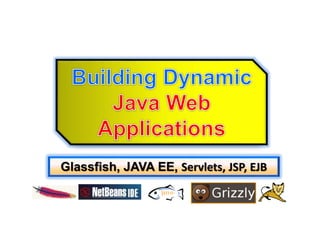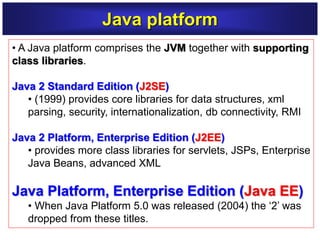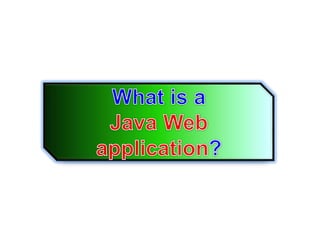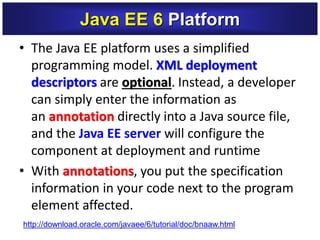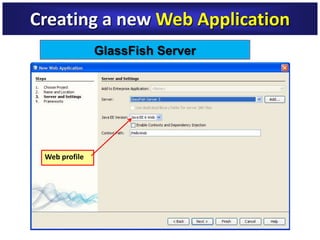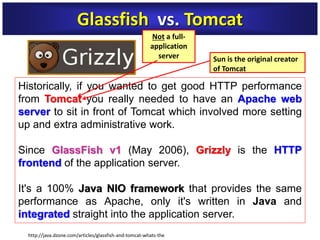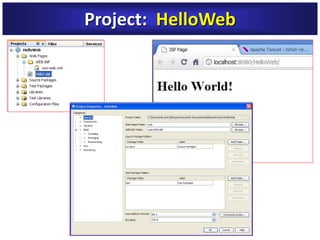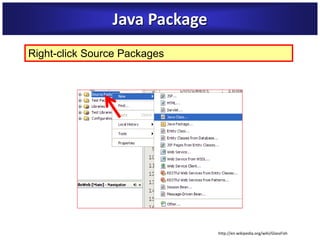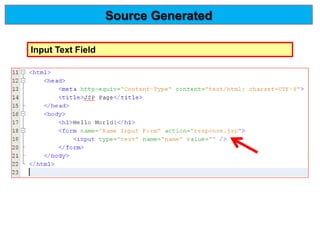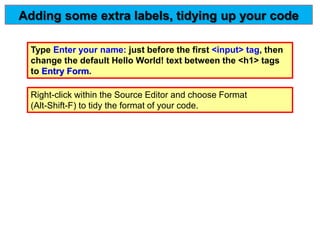Lecture 19 - Dynamic Web - JAVA - Part 1.ppt
- 1. Glassfish, JAVA EE, Servlets, JSP, EJB
- 2. • A Java platform comprises the JVM together with supporting class libraries. Java 2 Standard Edition (J2SE) • (1999) provides core libraries for data structures, xml parsing, security, internationalization, db connectivity, RMI Java 2 Platform, Enterprise Edition (J2EE) • provides more class libraries for servlets, JSPs, Enterprise Java Beans, advanced XML Java Platform, Enterprise Edition (Java EE) • When Java Platform 5.0 was released (2004) the ‘2’ was dropped from these titles. Java platform
- 3. • A Java platform comprises the JVM together with supporting class libraries. Java Micro Edition (Java ME) • comprises the necessary core libraries and tools for writing Java for embedded systems and other small footprint platforms, along with some specialised libraries for specific types of device such as mobile phones. Java platform
- 5. A Java web application generates interactive web pages containing various types of markup language (HTML, XML, and so on) and dynamic content. It is typically comprised of web components such as: • JavaServer Pages (JSP) • Servlets • JavaBeans to modify and temporarily store data, interact with databases and web services, and render content in response to client requests. Java Web Application https://grizzly.dev.java.net/
- 7. Java EE (Enterprise Edition) is a widely used platform containing a set of coordinated technologies that significantly reduce the cost and complexity of: • developing • deploying and • managing multitier, server-centric applications. Java EE builds upon the Java SE platform and provides a set of APIs (application programming interfaces) for developing and running portable, robust, scalable, reliable and secure server-side applications. Java EE (Enterprise Edition) http://netbeans.org/kb/trails/java-ee.html Java EE 6 is supported only by the GlassFish server v3.x.
- 8. • The Java EE platform uses a simplified programming model. XML deployment descriptors are optional. Instead, a developer can simply enter the information as an annotation directly into a Java source file, and the Java EE server will configure the component at deployment and runtime • With annotations, you put the specification information in your code next to the program element affected. Java EE 6 Platform http://download.oracle.com/javaee/6/tutorial/doc/bnaaw.html
- 9. • an architecture for implementing services as multitier applications that deliver the scalability, accessibility, and manageability needed by enterprise-level applications. • With this structure you can more easily change one of the tiers without compromising your entire application. • Business and presentation logic - to be implemented by the developer • Standard system services – to be provided by the Java EE platform Java EE application model http://download.oracle.com/javaee/6/tutorial/doc/bnaaw.html
- 11. • Servlets are Java classes that dynamically process requests and construct responses. • Server side replacement for CGI • Extensions to Java enabled web-servers • Inherently multi-threaded. • One thread per request. • Very efficient. • Platform independent. Java Servlets
- 12. • Servlets run inside a Web Container - the component of the web server that runs and interacts with Servlets • Servlet is running on the server listening for requests • When a request comes in, a new thread is generated by the web container. How do Servlets work?
- 14. Java EE containers • are the interface between a Java component and the low-level platform-specific functionality (i.e. transaction and state management, multithreading, resource pooling, etc.) that supports the component. • provide for the separation of business logic from resource and lifecycle management. • this allows developers to focus on writing business logic rather than writing enterprise infrastructure. Java EE Containers http://www.oracle.com/technetwork/java/javaee/javaee-faq-jsp-135209.html#diff The Java EE platform uses "containers" to simplify development. http://download.oracle.com/javaee/6/tutorial/doc/bnabo.html
- 15. Java EE Containers When a request comes in: • a Servlet needs to be instantiated and create a new thread to handle the request. • call the Servlet’s doPost()or doGet() method and pass the HTTP request and HTTP response objects • get the request and the response to the Servlet • manage the life, death and resources of the Servlet * All of the above are the tasks of the web container.
- 16. Java EE SERVER Java EE Containers From Bodoff et. al. 2005
- 17. Client Web server HTML Server MySQL Operating System PHP interpreter Internet My codes HTTP TCP/IP • Webserver supports HTTP. Recall: (PHP-MySQL) Server: response Web browser Operating System
- 18. Client Web browser Operating System Web server Servlet (Java code) Server Operating System Internet Web Container Application (Java code) HTTP TCP/IP • Webserver supports HTTP. Historically (Java Web App) Server: response GET... GET... It’s the Container that gives the Servlet the HTTP request and response, and it’s the Container that calls the Servlet’s methods (e.g. doPost() or doGet()) <html> <head> </head> <body> ... <body> </html> <html> <head> </head> <body> ... <body> </html>
- 19. Client Web browser Operating System Web server Servlet (Java code) Server Operating System Internet HTTP TCP/IP • Webserver supports HTTP. Historically (Java Web App) Server: response GET... GET... It’s the Container that gives the Servlet the HTTP request and response, and it’s the Container that calls the Servlet’s methods (e.g. doPost() or doGet()) <html> <head> </head> <body> ... <body> </html> <html> <head> </head> <body> ... <body> </html>
- 20. Client Web browser Operating System Web server + Container Servlet (Java code) Server Operating System Internet HTTP TCP/IP • Webserver supports HTTP. (Java Web App) Server: response GET... It’s the Container that gives the Servlet the HTTP request and response, and it’s the Container that calls the Servlet’s methods (e.g. doPost() or doGet()) <html> <head> </head> <body> ... <body> </html> Grizzly is now the HTTP front end of the application server
- 21. Java Servlets simplify web development by providing infrastructure for component, communication, and session management in a web container that is integrated with a web server. Java Servlets http://www.oracle.com/technetwork/java/javaee/javaee-faq-jsp-135209.html#diff • Writing Servlets is like writing Java codes that place an HTML page inside a Java class (this is the worst part of Servlets!) • (Historically!) requires a deployment descriptor (DD). This is in the form of an XML file. • Servlets do not have a main() method. • Servlets are under the control of another Java application called a Container
- 22. • manage the data flow between the following: • JavaBeans components are not considered Java EE components by the Java EE specification. • JavaBeans components have properties and have get and set methods for accessing the properties. JavaBeans Client/Database Server application client or applet components running on the Java EE server database Server components
- 23. Enterprise JavaBeans container handles: • distributed communication • threading • scaling • transaction management, etc. has a new packaging! (see figure) Enterprise JavaBeans (EJB) http://www.oracle.com/technetwork/java/deepdivejavaee6glassfishv3-jsp-138230.html New EJB 3.1 Packaging Older EJB Packaging
- 24. • create a simple web application using NetBeans IDE • deploy it to a server, and • view its presentation in a browser
- 25. • A 3rd party Java Integrated Development Environment (IDE) • Comes with Java EE class libraries • bundled with GlassFish Sever Open Source Edition • Can deploy servlets, JSPs, and web services NetBeans Class libraries for Servlets, JSPs, Enterprise Java Beans, advanced XML
- 26. A Quick Tour of the IDE (v.6.9) JSP, Java Bean, User-defined Java Class & Package, Get Method, User Interface
- 27. Sample Project Index.jsp NameHandler.java Main interface, Html with form Invokes response.jsp through form action. response.jsp Class NameHandler containing user data Generates the server’s response Defines a JavaBean to connect the class NameHandler to the user’s input via a form text field (name).
- 28. Creating a new Web Application New Project / Java Web
- 29. Creating a new Web Application Specify Project Name
- 30. Creating a new Web Application GlassFish Server Web profile
- 31. GlassFish is an open source application server project led by Sun Microsystems for the Java EE platform. The proprietary version is called Oracle GlassFish Enterprise Server. GlassFish is free software Java Application Server: Glassfish It uses a derivative of Apache Tomcat as the servlet container for serving Web content, with an added component called Grizzly which uses Java NIO for scalability and speed. Before the advent of the Java New I/O API (NIO), thread management issues made it impossible for a server to scale to thousands of users https://grizzly.dev.java.net/ Sun is the original creator of Tomcat http://java.dzone.com/articles/glassfish-and-tomcat-whats-the
- 32. GlassFish is an open source (full) application server project led by Sun Microsystems for the Java EE platform. The proprietary version is called Oracle GlassFish Enterprise Server. GlassFish is free software. Java Application Server: Glassfish It uses a derivative of Apache Tomcat as the servlet container for serving Web content, with an added component called Grizzly which uses Java NIO for scalability and speed. On 25 March 2010, soon after the acquisition of Sun Microsystems, Oracle issued a Roadmap for versions 3.0.1, 3.1, 3.2 and 4.0 with themes revolving around clustering, virtualization and integration with Coherence and other Oracle technologies. http://en.wikipedia.org/wiki/GlassFish
- 33. Historically, if you wanted to get good HTTP performance from Tomcat you really needed to have an Apache web server to sit in front of Tomcat which involved more setting up and extra administrative work. Since GlassFish v1 (May 2006), Grizzly is the HTTP frontend of the application server. It's a 100% Java NIO framework that provides the same performance as Apache, only it's written in Java and integrated straight into the application server. Glassfish vs. Tomcat Sun is the original creator of Tomcat http://java.dzone.com/articles/glassfish-and-tomcat-whats-the Not a full- application server
- 34. Other Java web application-capable Servers • Blazix from Desiderata Software (1.5 Megabytes, JSP, Servlets and EJBs) • TomCat from Apache (Approx 6 Megabytes) • WebLogic from BEA Systems (Approx 40 Megabytes, JSP, Servlets and EJBs) • WebSphere from IBM (Approx 100 Megabytes, JSP, Servlets and EJBs) http://www.jsptut.com/Getfamiliar.jsp
- 35. Commercial Deployment • Oracle GlassFish Server – delivers a flexible, lightweight and extensible Java EE 6 platform. It provides a small footprint, fully featured Java EE application server that is completely supported for commercial deployment and is available as a standalone offering. • Oracle WebLogic Server – designed to run the broader portfolio of Oracle Fusion Middleware and large-scale enterprise applications. – industry's most comprehensive Java platform for developing, deploying, and integrating enterprise applications. Oracle provides software support only for Oracle GlassFish Server, not for GlassFish Server Open Source Edition http://docs.sun.com/app/docs/doc/821-1751/gkbtb?l=en&a=view
- 36. Creating a new Web Application JSP File
- 37. Creating a new Web Application Sample Run
- 39. HelloWeb: Directories and Files
- 40. NameHandler.java
- 41. Java Package Right-click Source Packages http://en.wikipedia.org/wiki/GlassFish
- 42. Java Package Add a Java Class, specify Package name http://en.wikipedia.org/wiki/GlassFish Java Package • a mechanism for organizing Java classes into namespaces • can be stored in compressed files called JAR files, allowing classes to download faster as a group rather than one at a time.
- 43. Java Package Add a Java Class http://en.wikipedia.org/wiki/GlassFish
- 44. Java Package Edit the Java Class http://en.wikipedia.org/wiki/GlassFish • Declare a String variable inside the class declaration. String name; • Add a constructor to the class: public NameHandler() • Add the following line in the NameHandler() constructor: name = null;
- 45. Generating Getter and Setter Methods Right-click name field in the Source editor Selection: Name Field / Refactor / Encapsulate Fields
- 46. Generating Getter and Setter Methods Notice that Fields' Visibility is by default set to private, and Accessors' Visibility to public, indicating that the access modifier for class variable declaration will be specified as private, whereas getter and setter methods will be generated with public and private modifiers, respectively.
- 47. Generating Getter and Setter Methods Select the Refactor button.
- 48. Notice that the variable declaration has changed. • set to private Get and set functions with implementation have been added as well. • access modifier: public Results of Refactoring
- 49. Adding and Customising a Form, input text field, submit button
- 50. Invoke the palette: from the menu, select (Window/Palette): or press Ctrl+Shift+8 expand HTML Forms Inserting a Form
- 51. expand HTML Forms and drag a Form item to a point after the <h1> tags in the Source Editor. The Insert Form dialog box displays. Inserting a Form
- 52. Specify the following values: Click OK. Specifying an action
- 53. An HTML form is automatically added to the index.jsp file. Source Generated
- 54. Drag a Text Input item to a point just before the </form> tag, then specify the following values: • Name: name • Type: text Adding an Input Text Field
- 55. Input Text Field Source Generated
- 56. Drag a Button item to a point just before the </form> tag. Specify the following values: • Label: OK • Type: submit Click OK. An HTML button is added between the <form> tags. Adding a Submit Button
- 57. Type Enter your name: just before the first <input> tag, then change the default Hello World! text between the <h1> tags to Entry Form. Adding some extra labels, tidying up your code Right-click within the Source Editor and choose Format (Alt-Shift-F) to tidy the format of your code.
- 58. index.jsp: Source Generated We would like to pass this to our server
- 59. response.jsp
- 60. In the Projects window, right-click the HelloWeb project node and choose New > JSP. The New JSP File wizard opens. Name the file response, and click Finish. Notice that a response.jsp file node displays in the Projects window beneath index.jsp, and the new file opens in the Source Editor. Adding a JSP File
- 61. JSP Source File Generated: response.jsp
- 62. In the Palette to the right of the Source Editor, expand JSP and drag a Use Bean item to a point just below the <body> tag in the Source Editor. The Insert Use Bean dialog opens. Specify the values shown in the following figure. Adding a Use Bean item The class NameHandler belongs to the package we have set earlier
- 63. JSP Source File Generated: response.jsp Notice that the <jsp:useBean> tag is added beneath the <body> tag.
- 64. Drag a Set Bean Property item from the Palette to a point just before the <h1> tag and click OK. In the <jsp:setProperty> tag that appears, delete the empty value attribute and edit as follows. Delete the value = "" attribute if the IDE created it! Otherwise, it overwrites the value for name that you pass in index.jsp. Adding a Set Bean property item
- 65. Drag a Set Bean Property item from the Palette to a point just before the <h1> tag and click OK. In the <jsp:setProperty> tag that appears, delete the empty value attribute and edit as follows. Delete the value = "" attribute if the IDE created it! Otherwise, it overwrites the value for name that you pass in index.jsp. Adding a Set Bean property item
- 66. Drag a Get Bean Property item from the Palette and drop it after the comma between the <h1> tags. Specify the following values in the Insert Get Bean Property dialog: • Bean Name: mybean • Property Name: name Adding a Get Bean property item Insert a Get Bean Property item here!
- 67. the user input coming from index.jsp becomes a name/value pair that is passed to the request object. When you set a property using the <jsp:setProperty> tag, you can specify the value according to the name of a property contained in the request object. JSP Source Code Generated Therefore, by setting property to name, you can retrieve the value specified by user input.
- 68. Sample Run User input Response from the JSP file
- 69. Sample Run User input Response from the JSP file Index.jsp NameHandler.java Main interface, Html with form Invokes response.jsp through form action. response.jsp Class NameHandler containing user data, get and set methods Generates the server’s response Defines a JavaBean to connect the class NameHandler to the user’s input via a form text field (name).
- 70. Project Index.jsp NameHandler.java Main interface, Html with form Invokes response.jsp through form action. response.jsp Class NameHandler containing user data, get and set methods Generates the server’s response Defines a JavaBean to connect the class NameHandler to the user’s input via a form text field (name). http://java.sun.com/blueprints/code/projectconventions.html
- 71. The Java EE specification defines how the web application can be archived into a web application archive (WAR) • WAR files are – Java archives with a .war extension – Packaged using the same specification as zip files – Understood by all Java EE compliant application servers • WAR files can be directly deployed in servlet containers such as Tomcat Packaging Web Applications
- 72. • To make a WAR for your NetBeans project, right click on the project node and select Build Project. • The WAR file will be placed in the “dist” sub-directory of your project folder NetBeans WAR files
- 73. http://netbeans.org/kb/docs/web/quickstart-webapps.html http://www.oracle.com/technetwork/java/javaee/documentation/index.html http://netbeans.org/kb/docs/javaee/ecommerce/design.html E-Commerce Example http://netbeans.org/kb/docs/javaee/ecommerce/data-model.html#createERDiagram http://netbeans.org/kb/docs/web/mysql-webapp.html Simple Database Example Project http://download.oracle.com/javaee/6/tutorial/doc/ Java EE 6 NetBeans http://java.sun.com/blueprints/code/projectconventions.html Recommended Directory Structure for Projects
Editor's Notes
- #3: New I/O, usually called NIO, is a collection of Java programming language APIs that offer features for intensiveI/O operations. It was introduced with the J2SE 1.4 release of Java by Sun Microsystems to complement an existing standard I/O. NIO was developed under the Java Community Process as JSR 51.[1] As of 2006, an extension to NIO, called NIO2, is being developed under JSR 203; JSR 203 is scheduled to be included in Java SE 7 ("Dolphin")
- #4: New I/O, usually called NIO, is a collection of Java programming language APIs that offer features for intensiveI/O operations. It was introduced with the J2SE 1.4 release of Java by Sun Microsystems to complement an existing standard I/O. NIO was developed under the Java Community Process as JSR 51.[1] As of 2006, an extension to NIO, called NIO2, is being developed under JSR 203; JSR 203 is scheduled to be included in Java SE 7 ("Dolphin")
- #6: New I/O, usually called NIO, is a collection of Java programming language APIs that offer features for intensiveI/O operations. It was introduced with the J2SE 1.4 release of Java by Sun Microsystems to complement an existing standard I/O. NIO was developed under the Java Community Process as JSR 51.[1] As of 2006, an extension to NIO, called NIO2, is being developed under JSR 203; JSR 203 is scheduled to be included in Java SE 7 ("Dolphin")
- #8: New I/O, usually called NIO, is a collection of Java programming language APIs that offer features for intensiveI/O operations. It was introduced with the J2SE 1.4 release of Java by Sun Microsystems to complement an existing standard I/O. NIO was developed under the Java Community Process as JSR 51.[1] As of 2006, an extension to NIO, called NIO2, is being developed under JSR 203; JSR 203 is scheduled to be included in Java SE 7 ("Dolphin")
- #15: New I/O, usually called NIO, is a collection of Java programming language APIs that offer features for intensiveI/O operations. It was introduced with the J2SE 1.4 release of Java by Sun Microsystems to complement an existing standard I/O. NIO was developed under the Java Community Process as JSR 51.[1] As of 2006, an extension to NIO, called NIO2, is being developed under JSR 203; JSR 203 is scheduled to be included in Java SE 7 ("Dolphin")
- #16: New I/O, usually called NIO, is a collection of Java programming language APIs that offer features for intensiveI/O operations. It was introduced with the J2SE 1.4 release of Java by Sun Microsystems to complement an existing standard I/O. NIO was developed under the Java Community Process as JSR 51.[1] As of 2006, an extension to NIO, called NIO2, is being developed under JSR 203; JSR 203 is scheduled to be included in Java SE 7 ("Dolphin")
- #22: New I/O, usually called NIO, is a collection of Java programming language APIs that offer features for intensiveI/O operations. It was introduced with the J2SE 1.4 release of Java by Sun Microsystems to complement an existing standard I/O. NIO was developed under the Java Community Process as JSR 51.[1] As of 2006, an extension to NIO, called NIO2, is being developed under JSR 203; JSR 203 is scheduled to be included in Java SE 7 ("Dolphin")
- #23: New I/O, usually called NIO, is a collection of Java programming language APIs that offer features for intensiveI/O operations. It was introduced with the J2SE 1.4 release of Java by Sun Microsystems to complement an existing standard I/O. NIO was developed under the Java Community Process as JSR 51.[1] As of 2006, an extension to NIO, called NIO2, is being developed under JSR 203; JSR 203 is scheduled to be included in Java SE 7 ("Dolphin")
- #24: New I/O, usually called NIO, is a collection of Java programming language APIs that offer features for intensiveI/O operations. It was introduced with the J2SE 1.4 release of Java by Sun Microsystems to complement an existing standard I/O. NIO was developed under the Java Community Process as JSR 51.[1] As of 2006, an extension to NIO, called NIO2, is being developed under JSR 203; JSR 203 is scheduled to be included in Java SE 7 ("Dolphin")
- #26: New I/O, usually called NIO, is a collection of Java programming language APIs that offer features for intensiveI/O operations. It was introduced with the J2SE 1.4 release of Java by Sun Microsystems to complement an existing standard I/O. NIO was developed under the Java Community Process as JSR 51.[1] As of 2006, an extension to NIO, called NIO2, is being developed under JSR 203; JSR 203 is scheduled to be included in Java SE 7 ("Dolphin")
- #32: New I/O, usually called NIO, is a collection of Java programming language APIs that offer features for intensiveI/O operations. It was introduced with the J2SE 1.4 release of Java by Sun Microsystems to complement an existing standard I/O. NIO was developed under the Java Community Process as JSR 51.[1] As of 2006, an extension to NIO, called NIO2, is being developed under JSR 203; JSR 203 is scheduled to be included in Java SE 7 ("Dolphin")
- #33: New I/O, usually called NIO, is a collection of Java programming language APIs that offer features for intensiveI/O operations. It was introduced with the J2SE 1.4 release of Java by Sun Microsystems to complement an existing standard I/O. NIO was developed under the Java Community Process as JSR 51.[1] As of 2006, an extension to NIO, called NIO2, is being developed under JSR 203; JSR 203 is scheduled to be included in Java SE 7 ("Dolphin")
- #34: New I/O, usually called NIO, is a collection of Java programming language APIs that offer features for intensiveI/O operations. It was introduced with the J2SE 1.4 release of Java by Sun Microsystems to complement an existing standard I/O. NIO was developed under the Java Community Process as JSR 51.[1] As of 2006, an extension to NIO, called NIO2, is being developed under JSR 203; JSR 203 is scheduled to be included in Java SE 7 ("Dolphin")
- #42: New I/O, usually called NIO, is a collection of Java programming language APIs that offer features for intensiveI/O operations. It was introduced with the J2SE 1.4 release of Java by Sun Microsystems to complement an existing standard I/O. NIO was developed under the Java Community Process as JSR 51.[1] As of 2006, an extension to NIO, called NIO2, is being developed under JSR 203; JSR 203 is scheduled to be included in Java SE 7 ("Dolphin")
- #43: New I/O, usually called NIO, is a collection of Java programming language APIs that offer features for intensiveI/O operations. It was introduced with the J2SE 1.4 release of Java by Sun Microsystems to complement an existing standard I/O. NIO was developed under the Java Community Process as JSR 51.[1] As of 2006, an extension to NIO, called NIO2, is being developed under JSR 203; JSR 203 is scheduled to be included in Java SE 7 ("Dolphin")
- #44: New I/O, usually called NIO, is a collection of Java programming language APIs that offer features for intensiveI/O operations. It was introduced with the J2SE 1.4 release of Java by Sun Microsystems to complement an existing standard I/O. NIO was developed under the Java Community Process as JSR 51.[1] As of 2006, an extension to NIO, called NIO2, is being developed under JSR 203; JSR 203 is scheduled to be included in Java SE 7 ("Dolphin")
- #45: New I/O, usually called NIO, is a collection of Java programming language APIs that offer features for intensiveI/O operations. It was introduced with the J2SE 1.4 release of Java by Sun Microsystems to complement an existing standard I/O. NIO was developed under the Java Community Process as JSR 51.[1] As of 2006, an extension to NIO, called NIO2, is being developed under JSR 203; JSR 203 is scheduled to be included in Java SE 7 ("Dolphin")
- #46: New I/O, usually called NIO, is a collection of Java programming language APIs that offer features for intensiveI/O operations. It was introduced with the J2SE 1.4 release of Java by Sun Microsystems to complement an existing standard I/O. NIO was developed under the Java Community Process as JSR 51.[1] As of 2006, an extension to NIO, called NIO2, is being developed under JSR 203; JSR 203 is scheduled to be included in Java SE 7 ("Dolphin")
- #47: New I/O, usually called NIO, is a collection of Java programming language APIs that offer features for intensiveI/O operations. It was introduced with the J2SE 1.4 release of Java by Sun Microsystems to complement an existing standard I/O. NIO was developed under the Java Community Process as JSR 51.[1] As of 2006, an extension to NIO, called NIO2, is being developed under JSR 203; JSR 203 is scheduled to be included in Java SE 7 ("Dolphin")
- #48: New I/O, usually called NIO, is a collection of Java programming language APIs that offer features for intensiveI/O operations. It was introduced with the J2SE 1.4 release of Java by Sun Microsystems to complement an existing standard I/O. NIO was developed under the Java Community Process as JSR 51.[1] As of 2006, an extension to NIO, called NIO2, is being developed under JSR 203; JSR 203 is scheduled to be included in Java SE 7 ("Dolphin")
- #49: New I/O, usually called NIO, is a collection of Java programming language APIs that offer features for intensiveI/O operations. It was introduced with the J2SE 1.4 release of Java by Sun Microsystems to complement an existing standard I/O. NIO was developed under the Java Community Process as JSR 51.[1] As of 2006, an extension to NIO, called NIO2, is being developed under JSR 203; JSR 203 is scheduled to be included in Java SE 7 ("Dolphin")
